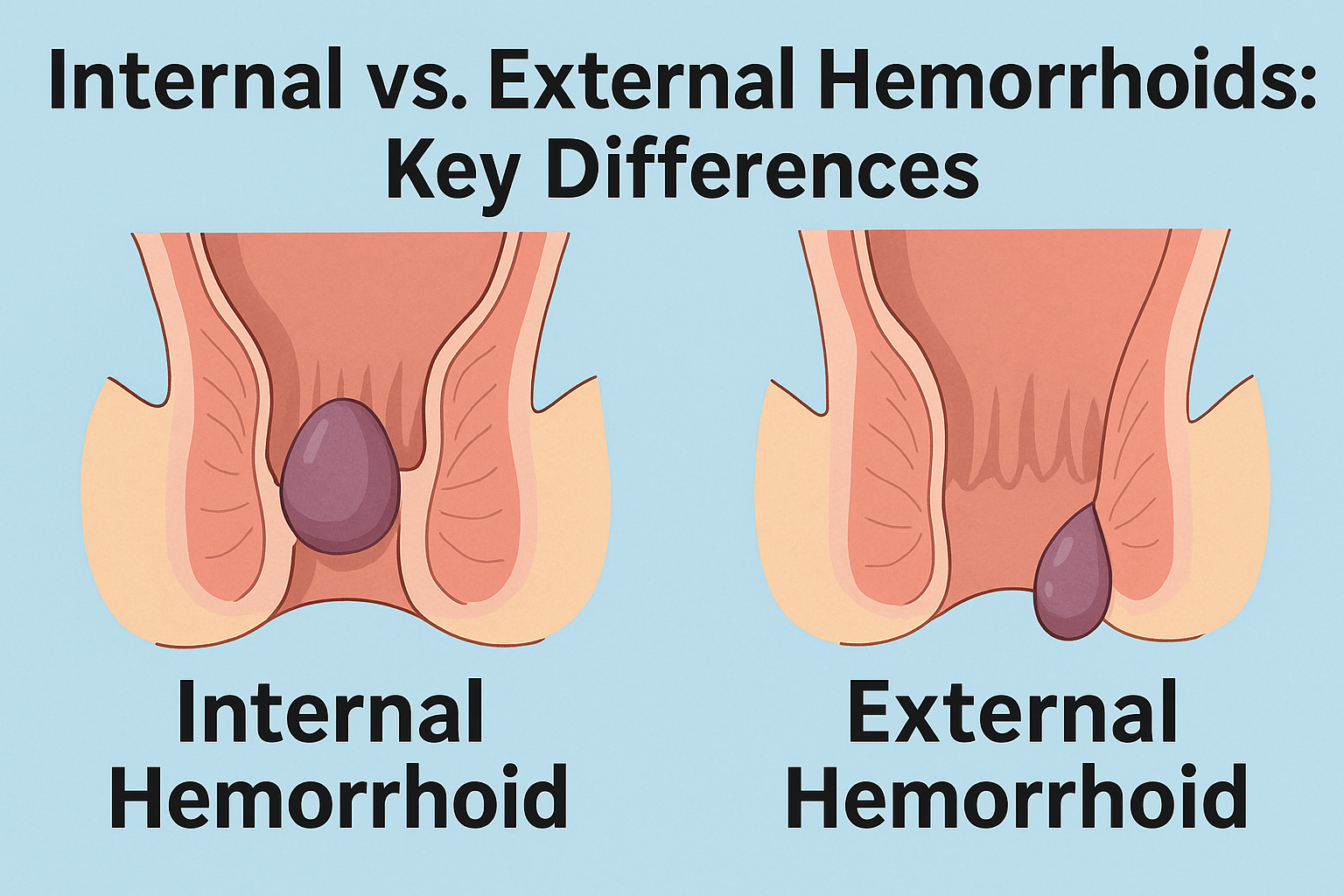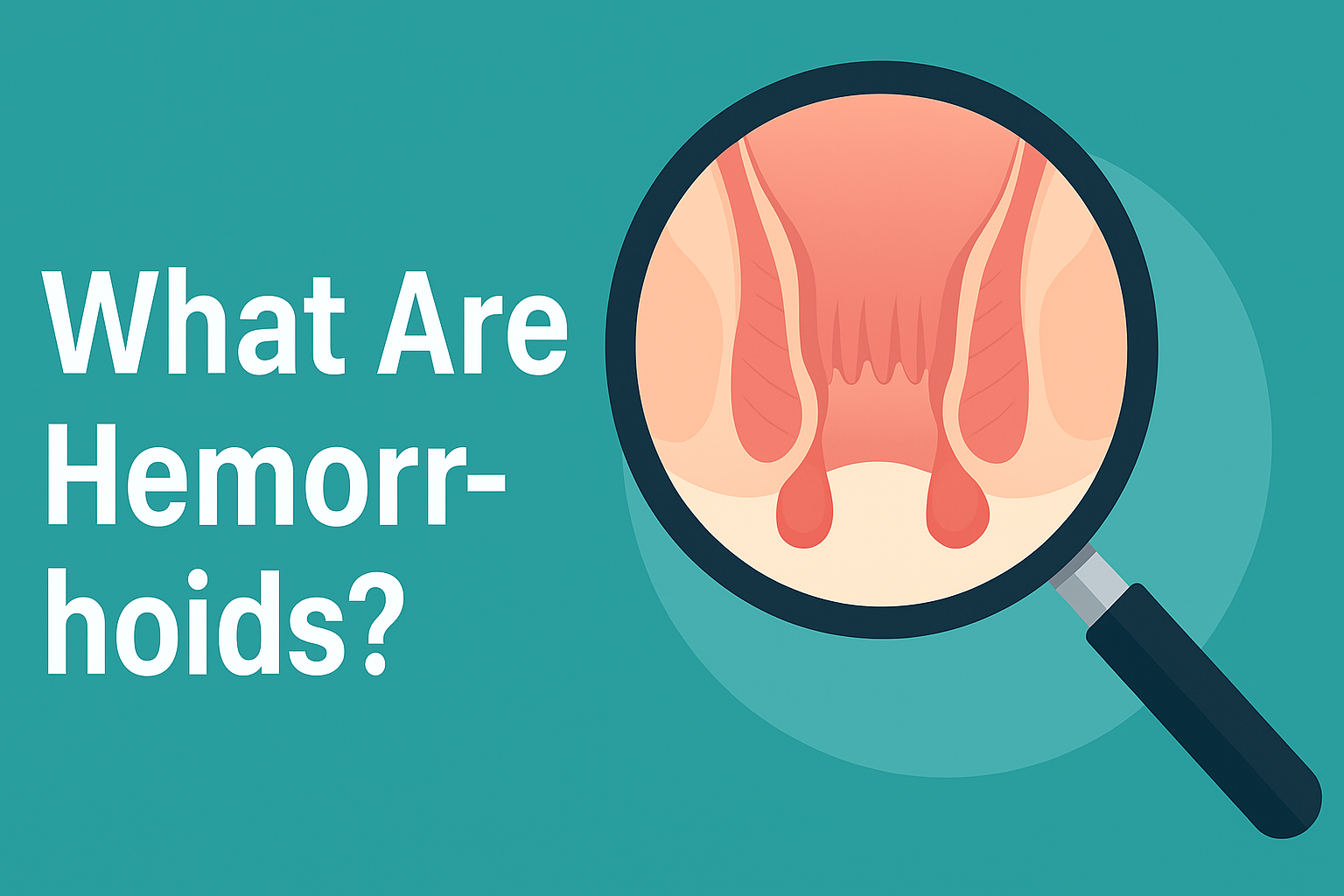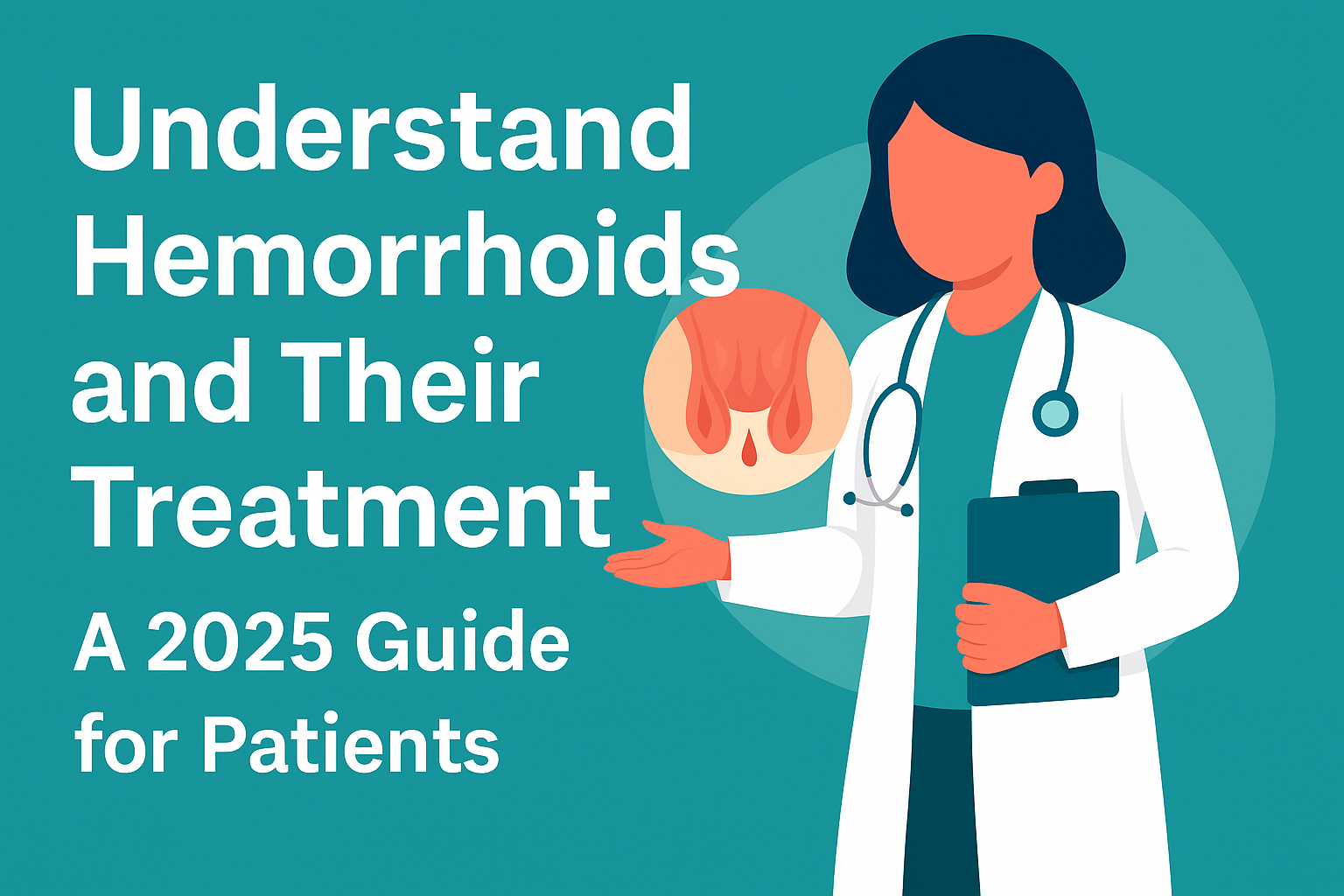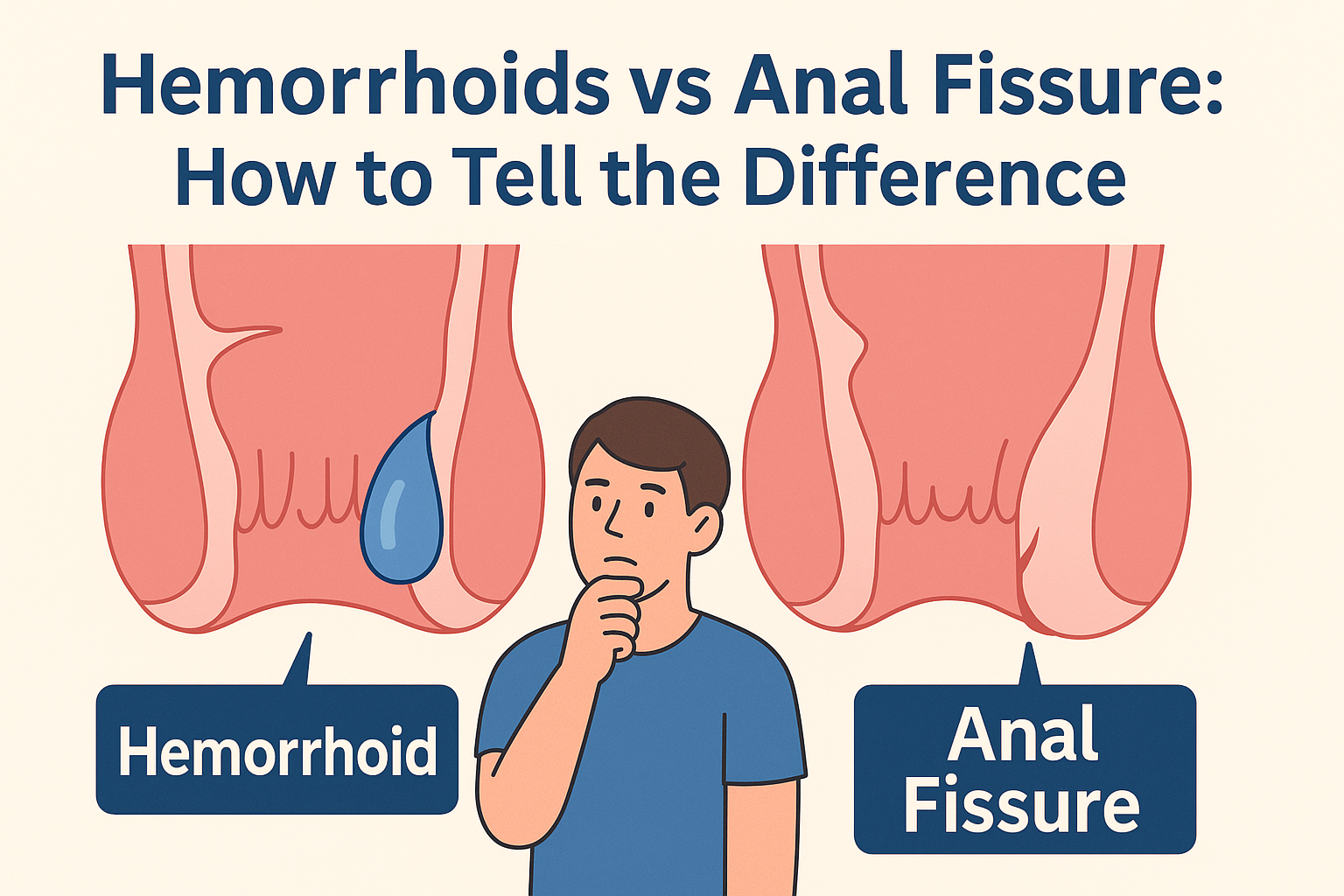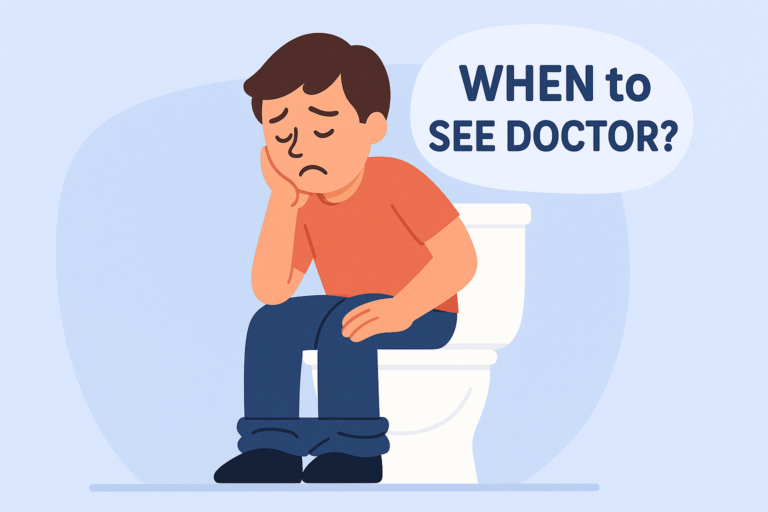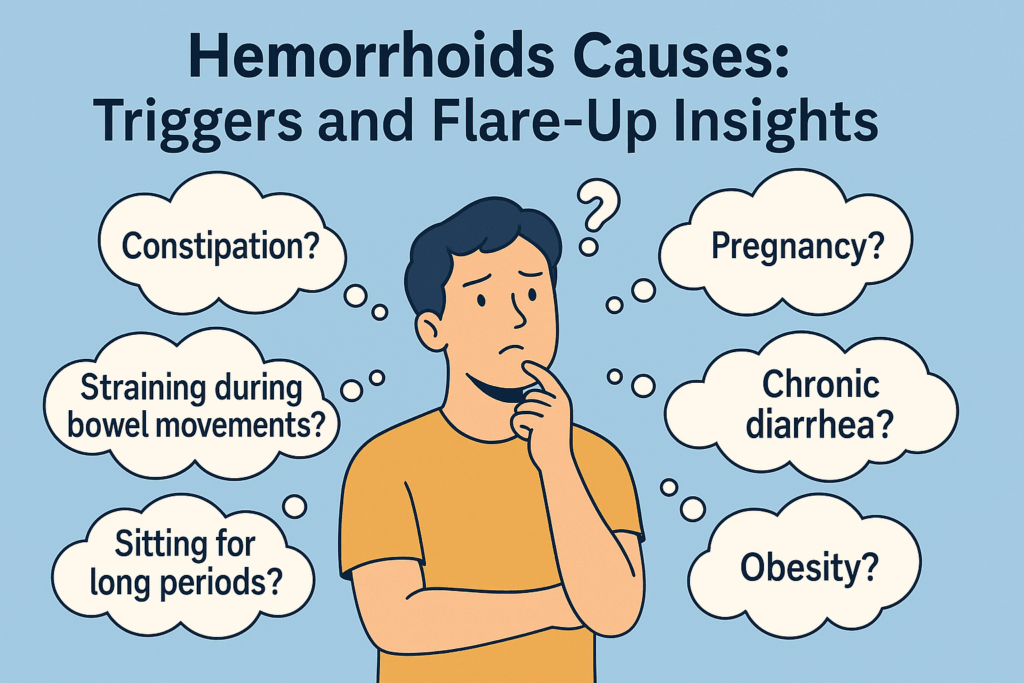
Hemorrhoids are a common yet rarely discussed condition that affects millions of people worldwide. With nearly half the population experiencing symptoms by age 50, many of us have either dealt with hemorrhoids or will face them at some point. This article explores the key factors that trigger hemorrhoid flare-ups, including various hemorrhoids causes, helping you understand how to prevent and manage this uncomfortable condition.
Straining During Bowel Movements and Extended Toilet Time
One of the primary causes of hemorrhoid flare-ups is excessive straining during bowel movements. By straining you are causing more hemorrhoids and creating more symptoms, as the increased pressure in the rectal area forces blood to pool in the veins, leading to swelling and inflammation.
The time spent sitting on the toilet also plays a significant role. Prolonged sitting puts extra pressure on the veins in your rectal area, which must work against gravity to return blood to the heart. Over time, this can lead to swelling and the formation of hemorrhoids.
Many people extend their toilet time by bringing smartphones or reading materials into the bathroom. This seemingly harmless habit can have serious consequences. Many patients are surprised to learn that sitting on the toilet for long periods can also lead to hemorrhoids. The shape of the toilet seat puts extra pressure on the rectum and anus. The toilet seat’s design creates a particular problem because the cutout center allows the rectum to sit lower than the buttocks, increasing pressure on the anal area.
Health experts recommend limiting toilet time to 5-10 minutes maximum and avoiding distractions that might extend your stay.
Chronic Constipation and Diarrhea: Dual Risks
Both constipation and diarrhea can trigger hemorrhoid flare-ups, though through different mechanisms:
Constipation’s Impact
Constipation is a well-known risk factor for hemorrhoids. One of the primary causes is constipation and related activities like straining and spending time on the toilet. Hard stools require more effort to pass, increasing pressure on the rectal veins. Additionally, the strain of pushing hard stools through the digestive tract can damage the delicate tissues surrounding hemorrhoids.
The cycle often becomes self-reinforcing: constipation leads to straining, which worsens hemorrhoids, which can then make bowel movements more painful, causing people to delay them, leading to harder stools and more constipation.
Diarrhea’s Surprising Role
Though less commonly discussed, diarrhea can also trigger hemorrhoid flare-ups. The cause of hemorrhoids is often said to be a burden on the anus due to constipation, but diarrhea may also be a cause. Frequent, loose bowel movements can irritate existing hemorrhoids and weaken the supporting tissues around them.
Diarrhea often contains bile or gastric acid, so passing the watery stool can irritate the rectum, which can cause hemorrhoids to flare up. The acids in diarrheal stool can cause inflammation and worsen symptoms in those who already have hemorrhoids.
Additionally, diarrhea often leads to more time spent on the toilet, creating the same pressure problems discussed earlier.
Sedentary Lifestyle: Circulation Problems from Sitting, Standing, and Lack of Exercise
Modern lifestyles often involve prolonged periods of sitting, which can significantly impact hemorrhoid health:
Extended Sitting
Whether at a desk, in a car, or on a couch, sitting for long periods restricts blood flow in the rectal area. The intense pressure from prolonged sitting leads to new hemorrhoids and aggravates existing ones. But not all sitting has the same effect. Sitting on a hard chair causes more pressure than a soft chair.
Prolonged Standing
Standing for extended periods can also contribute to hemorrhoid flare-ups. When standing, gravity pulls blood downward, potentially causing it to pool in the lower body, including the rectal area. This can increase pressure on hemorrhoidal veins, particularly for those whose occupations require standing for hours at a time.
Lack of Exercise
A sedentary lifestyle compounds the problems of extended sitting and standing. Regular exercise helps promote healthy bowel movements and prevents constipation, a major risk factor for hemorrhoids. An insufficient amount of physical activity can result in slower digestion and increased straining during bowel movements, creating ideal conditions for hemorrhoid development and flare-ups.
Regular physical activity improves overall circulation, helping prevent blood from pooling in the rectal veins. Even light exercises like walking can make a significant difference in hemorrhoid prevention.
Pregnancy and Hormonal Changes: Increased Pressure on Veins
Pregnancy is a time when many women experience hemorrhoids for the first time or notice existing hemorrhoids worsening:
Physical Pressure
Pregnancy and vaginal delivery predisposes women to develop hemorrhoids because of hormonal changes and increased intra-abdominal pressure. It has been estimated that 25% to 35% of pregnant women are affected by this condition. Nih As the pregnancy progresses and the uterus expands, it puts increasing pressure on the veins in the pelvic area, including those around the rectum.
Hormonal Factors
The hormonal changes during pregnancy also contribute significantly to hemorrhoid development. Hormone changes in your body slow the digestion process that helps you have regular bowel movements. The extra weight from the waste stuck in your bowel can squeeze the veins in your anus so that it’s harder for them to move blood.
Specifically, increased progesterone levels during pregnancy relax smooth muscles throughout the body, including those in vessel walls and the digestive tract. This relaxation can cause veins to dilate more easily and slow down digestion, potentially leading to constipation and increased pressure on hemorrhoids.
These factors often combine to make the third trimester particularly challenging for hemorrhoid management, with many women finding relief only after delivery.
Dietary Factors: Fiber and Fluid Imbalance
Diet plays a crucial role in hemorrhoid prevention and management, with fiber and fluid intake being particularly important:
Fiber Deficiency
Increasing fiber in your diet improves the health of the large intestine and is one of the best ways to soften your stools and prevent constipation. Without adequate fiber, stools become hard and difficult to pass, requiring more straining during bowel movements.
Most dietary guidelines recommend 20-35 grams of fiber daily, yet many people consume less than half this amount. Soluble fiber (found in oats, peas, beans, apples, citrus fruits, and barley) dissolves in water to form a gel-like substance that helps soften stools. Insoluble fiber (found in whole grains, wheat bran, nuts, and vegetables) adds bulk to stool, helping it pass more quickly through the digestive system.
Inadequate Fluid Intake
Fiber alone is not enough – adequate hydration is equally important. The fiber must be accompanied by adequate water intake to ensure that stool is not just bulky but also soft. NCBI Without enough fluid, even a high-fiber diet can lead to constipation as the fiber absorbs available water in the intestines, potentially making stools harder.
Water is the best choice for hydration, but most non-alcoholic, non-caffeinated beverages contribute to fluid intake. Caffeinated and alcoholic drinks may have a diuretic effect and can potentially contribute to dehydration, so they should not be counted toward daily fluid needs.
Obesity and Increased Abdominal Pressure
Excess body weight, particularly around the abdomen, significantly increases the risk of hemorrhoid flare-ups:
Direct Pressure Effects
Simply carrying extra weight can increase pressure on your rectum to the point where hemorrhoids may develop. Texashae The additional weight in the abdominal area presses downward on the pelvic floor and rectal veins, which can impede blood flow and contribute to vein swelling.
Secondary Lifestyle Factors
Obesity often comes with secondary factors that further increase hemorrhoid risk. Obesity is also strongly associated with poor dietary habits, such as consuming a diet low in fiber and high in processed foods. Fiber plays a vital role in facilitating regular bowel movements and preventing constipation.
Additionally, those with obesity may lead more sedentary lifestyles, reducing the benefits of physical activity on bowel function and circulation. The combination of excess weight, dietary patterns, and reduced physical activity creates multiple risk factors for hemorrhoid development.
Conclusion: Managing Hemorrhoid Risk Factors
Understanding what triggers hemorrhoid flare-ups is the first step toward effective prevention and management. By addressing these key factors—reducing straining and toilet time, managing constipation and diarrhea, staying active, being mindful of pregnancy-related changes, maintaining a fiber-rich diet with adequate hydration, and working toward a healthy weight—you can significantly reduce your risk of painful hemorrhoid episodes.
For those already experiencing hemorrhoids or early symptoms, some natural supplements may help provide relief. Learn more about beneficial hemorrhoid supplements in our comprehensive guide: 12 Best Hemorrhoid Supplement.
Remember that hemorrhoids are extremely common and nothing to be embarrassed about. With proper management of these risk factors, combined with supplements and medical help when necessary, most people can find significant relief from hemorrhoid symptoms and improve their overall digestive health.


